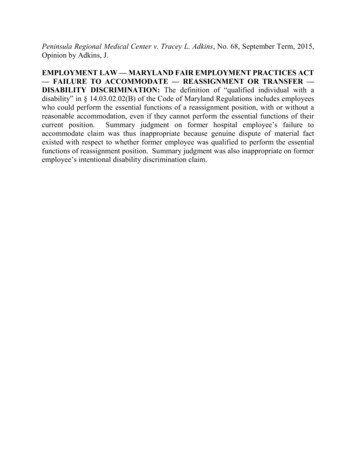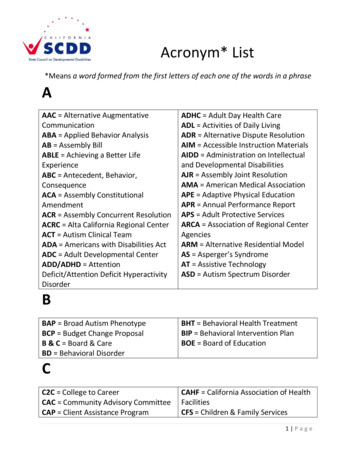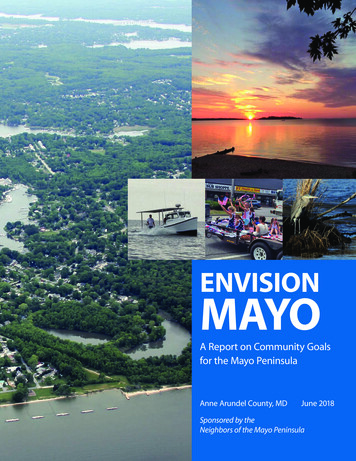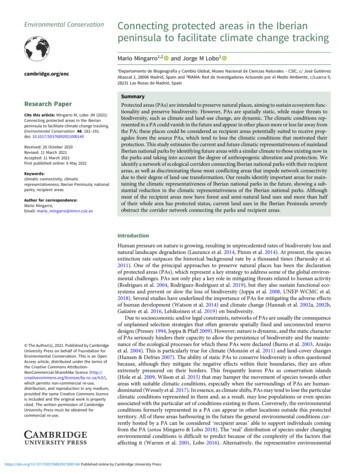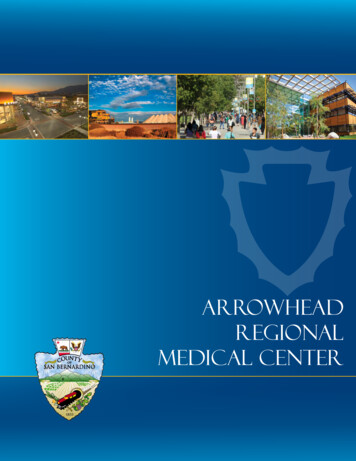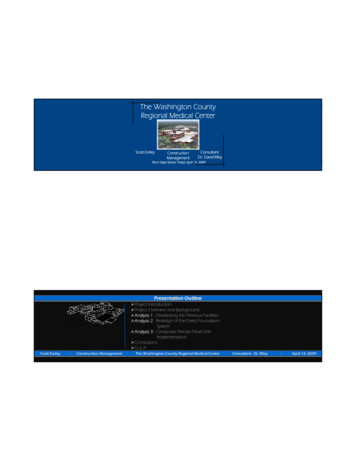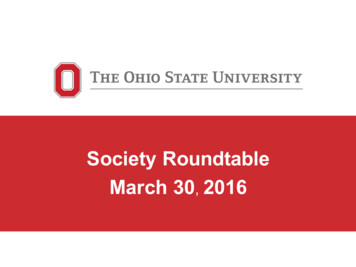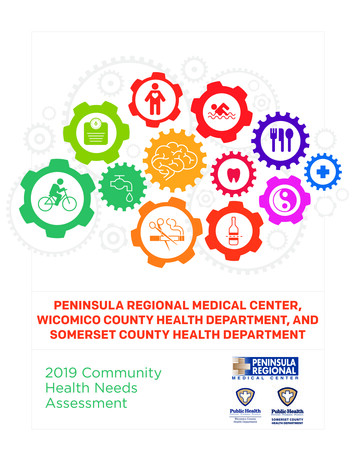
Transcription
PENINSULA REGIONAL MEDICAL CENTER,WICOMICO COUNTY HEALTH DEPARTMENT, ANDSOMERSET COUNTY HEALTH DEPARTMENT2019 CommunityHealth NeedsAssessment
TABLE OF CONTENTS1. Executive Summary17. Data Synthesis281.1 Introduction11.2 Summary of Findings18. Prioritized Significant Health Needs291.3 Selected Priority Areas22. Introduction2.1 About “The Partnership”38.1 Diabetes298.2 Cancer308.3 Behavioral Health3138.3.1 Mental Health & Mental Disorders322.1.1 PRMC38.3.2 Substance Abuse322.1.2 WCHD42.1.3 SCHD42.1.4 Definition of Community and Map52.1.5 Other Partnerships52.2 Consultants69. Non-Prioritized Significant Health Needs349.1 Access to Health Services349.2 Older Adults & Aging349.3 Oral Health3510. Other Findings363. Selected Priority Areas710.1 Transportation364.Evaluation of Progress since Prior CHNA810.2 Social Environment364.1 Impact since Prior CHNA810.3 Economy374.2 Community Feedback on Prior CHNA810.4 Low Income/Underserved375. Methods911. A Closer Look at Highly Impacted Populations 385.1 Secondary Data Sources and Analysis95.2 Primary Data Collection and Analysis912. Conclusion4013. Appendices415.2.1 Key Informant Interviews95.2.2 Focus Groups115.2.3 Community Survey125.3 Prioritization135.3.1 Prioritization Session Participants145.3.2 Prioritization Process145.3.3 Prioritization Results155.4 Data Considerations156. Demographics166.1 Population176.1.1 Population Count176.1.2 Age186.1.3 Racial/Ethnicity Diversity196.2 Social and Economic Determinants of Health 206.2.1 Income206.2.2 Poverty216.2.3 Education226.2.4 Languages Spoken246.2.5 Households with No Vehicle256.3 SocioNeeds Index 2613.1 Secondary Data13.1.1 Secondary Data Sources414113.1.2 Secondary Data Scoring DetailedMethodology4213.1.3 Comparisons4213.1.4 Secondary Data Scoring Results4413.2 Community Input6813.2.1 Key Informant Interview Questions6813.2.2 Focus Group Questions6813.2.3 Online Community Survey7013.3 Community Resources7213.4 Prioritization Toolkit7313.5 Impact Since Prior CHNA75
Figure 1. Map of Service AreaFigure 2. Key Informant Interview Themes510Figure 3. Focus Group Themes11Figure 4. Race/Ethnicity of Community Survey Respondents12Figure 5. Age of Community Survey Respondents13Figure 6. Prioritization Criteria14Figure 7. Prioritization Topic Area Rankings15Figure 8. Tri-County Service Area Population Count by Zip Code18Figure 9. Tri-County Service Area Demographics: Age19Figure 10. Tri-County Service Area Demographics: Race20Figure 11. Tri-County Service Area Demographics: Ethnicity20Figure 12. Tri-County Service Area Median Household Income21Figure 13. Tri-County Service Area Median Household Income by Race/Ethnicity22Figure 14. Tri-County Service Area Families Living Below the Poverty Level22Figure 15. Tri-County Service Area Map of Families Living in Poverty23Figure 16. Tri-County Service Area Educational Attainment by County24Figure 17. Tri-County Service Area Educational Attainment24Figure 18. Tri-County Service Area Language Spoken at Home25Figure 19. Tri-County Service Area Map of Households without a Vehicle26Figure 20. SocioNeeds Index Map for Tri-County Service Area27Figure 21. Data Synthesis Results29Figure 22. Data Scoring Methodology Steps43Table 1. SocioNeeds Index Zip Codes of Highest Need28Table 2. Diabetes-related Indicators of concern30Table 3. Cancer-related Indicators of concern32Table 4. Mental Health-related Indicators of concern33Table 5. Substance Abuse-related Indicators of concern34Table 6. Negative Race/Ethnicity Disparities by County39Table 7. Number of Indicators with Negative Sub-Population Disparities per County40
SECTION 1EXECUTIVESUMMARYINTRODUCTION1.1Peninsula Regional Medical Center (PRMC), Wicomico County Health Department(WCHD), and Somerset County Health Department (SCHD) are pleased to presentthe 2019 Community Health Needs Assessment (CHNA). This CHNA report wasdeveloped to provide an overview of the health needs in the PRMC Tri-County ServiceArea, including Somerset, Wicomico, and Worcester counties in Maryland. PRMC,WCHD, and SCHD partnered with Conduent Healthy Communities Institute (HCI) toconduct the CHNA. The goal of this report is to offer a meaningful understanding ofthe greatest health needs across the PRMC, WCHD, and SCHD service areas, as wellas to guide planning efforts to address those needs. Special attention has been givento identify health disparities, needs of vulnerable populations, unmet health needs orgaps in services, and input from the community.Members of the community are invited to provide feedback and comments on thisreport by emailing community.relations@peninsula.org.1.2SUMMARY OF FINDINGSThe CHNA findings are drawn from an analysis of an extensive set of secondarydata (over 100 indicators from national and state data sources) and in-depthprimary data from community health leaders and organizations that serve thecommunity at large, as well as non-health professionals and community members.The main source for the secondary data, or data that has been previously collected,is the Peninsula Regional Medical Center Creating Healthy Communities platform,a publicly available data platform that is embedded on the main PRMC website.That platform can be found here: y-communities. You can read in more detail about the methods behind thesecondary and primary data analysis in Section 5 of this report.Significant Health Needs based on primary and secondary data: 1Access to Health ServicesCancerDiabetesEconomyLow Income / UnderservedMental Health & Mental DisordersOlder Adults & AgingOral HealthSocial EnvironmentSubstance AbuseTransportationPENINSULA REGIONAL MEDICAL CENTER AND WICOMICO AND SOMERSET COUNTYHEALTH DEPARTMENTS COMMUNITY HEALTH NEEDS ASSESSMENTDECEMBER 2018
SECTION 1 EXECUTIVE SUMMARY1.3SELECTED PRIORITIZED AREASOn October 24, 2018, PRMC’s Community Benefit team and other members fromvarious departments in the hospital as well as representatives from WCHD andSCHD came together to prioritize the significant health needs in a session led byconsultants from HCI. While considering several prioritization criteria, the followingthree topics were identified as priorities to address: Behavioral Health (focusing on the combined topic areasof Mental Health & Mental Disorders as well as Substance Abuse) Diabetes Cancer2PENINSULA REGIONAL MEDICAL CENTER AND WICOMICO AND SOMERSET COUNTYHEALTH DEPARTMENTS COMMUNITY HEALTH NEEDS ASSESSMENTDECEMBER 2018
SECTION 2INTRODUCTION2.1ABOUT “THE PARTNERSHIP”A partnership was formed between PRMC, WCHD, and SCHD to collaborate forthe benefit of the community. These organizations have been partnering togetheron local assessment efforts since 1995. Two of the organizations are required tocomplete a CHNA: PRMC as a non-profit hospital and WCHD as an accreditedhealth department. SCHD is in the early phases of public health accreditation.2.1.1 PRMCMission: To improve the health of the communities we serve.Peninsula Regional Medical Center (PRMC) in Salisbury, Maryland offers the widestarray of specialty and subspecialty services on the Delmarva Peninsula.PRMC is one of just four hospitals in Maryland, and the only on the Eastern Shore,to be awarded a five-star rating — the highest possible — by the Centers forMedicare & Medicaid Services (CMS) in 2018 and 2019. In 2018 and 2019, it wasalso the recipient of an A safety grade by the Leapfrog Group and was named aDistinguished Hospital for Clinical Excellence by Healthgrades, placing it among thetop 5% of hospitals in the United States.At 288 acute care beds, PRMC is the 8th largest hospital in Maryland, and theregion’s largest, most advanced tertiary care facility, which has been meeting thehealthcare needs of Delmarva Peninsula residents since 1897. Its 3,300 physicians,staff, and volunteers provide safe, compassionate, and affordable care designedto exceed the expectations of the nearly 500,000 patients who rely on theMedical Center team each year for inpatient, outpatient, diagnostic, sub-acute andemergency/trauma services. It is the region’s oldest healthcare institution with themost experienced team of healthcare professionals. It also infuses over 500 millionannually into its regional economy, and is the recipient of over 125 national awards,recognitions, and certifications in the past half-decade for the care it offers patientsand the outcomes they experience.Peninsula Regional Medical Center offers a full range of services, includingneurosurgery, robotic surgery, cardiothoracic surgery, joint replacement,emergency/trauma care, wound care, women’s and children’s services, and weightloss and wellness services. Additionally, breast care and comprehensive cancer careare provided at institutes in Salisbury and Ocean Pines, MD, and community andpopulation health services are provided through a network of family medicine andspecialty care offices across Maryland and Delaware, health pavilions in Millsboro,DE and Ocean Pines, MD, and with the Wagner Wellness Van.3PENINSULA REGIONAL MEDICAL CENTER AND WICOMICO AND SOMERSET COUNTYHEALTH DEPARTMENTS COMMUNITY HEALTH NEEDS ASSESSMENTDECEMBER 2018
SECTION 2 INTRODUCTIONIn 2014, PRMC joined with Bayhealth of Delaware to form a partnership knownas HealthVisions Delmarva, LLC. The two health systems share best practices toprovide best-in-class healthcare services and leverage the intellectual assets ofeach organization for the benefit of their patients across Delmarva. However, eachmaintains its own financial autonomy. A similar partnership has been establishedwith six Western Shore Hospitals (Adventist Healthcare, Inc., LifeBridge Health, Inc.,Mercy Health Services, Inc., Frederick Regional Health System, Meritus, and WesternMaryland) to form the Advanced Health Collaborative, LLC.Peninsula Regional is also proud to be an affiliate of the Johns Hopkins ClinicalResearch Network (JHCRN), a group of academic and community-based clinicalresearchers designed to provide new opportunities for research collaborations. It’salso home to the Richard A. Henson Research Institute.New technologies, including robotic and small incision surgery, and advanceddisease detection and treatment options, continue to define the standard for safercare, faster recoveries, and better outcomes.Keep in touch with PRMC on Facebook at www.facebook.com/PeninsulaRegional,on the PRMC blog at prmcsalisbury.com, or on the Peninsula Regional website atwww.peninsula.org.2.1.2 WCHDMission: To maximize the health and wellness of all members of the communitythrough collaborative efforts.Vision: Healthy People in Healthy Communities.The local public health department, accredited by the Public Health AccreditationBoard on March 8, 2016, has expanded over the years to meet changing needsof the community and continually works toward protecting the health andenvironment of the people of Wicomico County.Health Department Leadership: Health Officer Lori Brewster MS, APRN/BC, LCADC Physician Deputy Health Officer James Cockey, M.D. Administrative Deputy Health Officer Darlene Jackson-Bowen, Ph.D., PA2.1.3 SCHDMission: Dedicated to serving the Public by preventing illness, promoting wellnessand protecting the health of our community.Vision: Healthy People in Healthy CommunitiesHealth Department Leadership: Health Officer Lori Brewster MS, APRN/BC, LCADC Acting Physician Deputy Health Officer James Cockey, M.D. Administrative Deputy Health Officer Danielle Weber, RN, MSThe Health Department continues to change with the changes in the healthcaresystem. Somerset County Health Department is in the initial planning stage of thePublic Health Accreditation process.4PENINSULA REGIONAL MEDICAL CENTER AND WICOMICO AND SOMERSET COUNTYHEALTH DEPARTMENTS COMMUNITY HEALTH NEEDS ASSESSMENTDECEMBER 2018
SECTION 2 INTRODUCTION2.1.4 DEFINITION OF COMMUNITY AND MAPPeninsula Regional Medical Center’s, Wicomico County Health Department’s, andSomerset County Health Department’s service areas are jointly defined by Somerset,Wicomico, and Worcester counties in the state of Maryland. These three countiesare referred to as the Tri-County Service Area. Additionally, the service area includesthe 43 zip codes and associated census places and census tracts within those threecounties.FIGURE 1. MAP OF SERVICE AREA2.1.5 OTHER PARTNERSHIPSBoth PRMC, WCHD, and SCHD leverage existing relationships with other organizationsand groups in order to further their community work. Some of the existingpartnerships include: COAT team — Wicomico County, PRMC, Local Law enforcement, and State’sAttorneys office Community classes for CDSMP, Falls, and PEARLS - PRMG, AGH, and PeninsulaRegional Clinically Integrated Network, MAC, Inc. Living Well Center of Excellence SWIFT — Salisbury Wicomico First Care Team, EMT-P, NP, RNs, CHWs —Wicomico County Health Department, Salisbury Fire Department, and PRMC Walkability — City of Salisbury, Wicomico County Health Department, and PRMC5PENINSULA REGIONAL MEDICAL CENTER AND WICOMICO AND SOMERSET COUNTYHEALTH DEPARTMENTS COMMUNITY HEALTH NEEDS ASSESSMENTDECEMBER 2018
SECTION 2 INTRODUCTION 2.2MOTA vendor (FY19 Community Empowerment Center)Veterans AdministrationLocal Behavioral Health AuthorityLive Healthy Wicomico CoalitionWalk WicomicoHOPE, Inc.Shore TransitDrs. Gray and AllenDelmarva Smile CornerPRMC Wagner Wellness VanEastern Shore Area Health Education CenterCONSULTANTSThe Partnership commissioned Conduent Healthy Communities Institute (HCI) toassist with its Community Health Needs Assessment and author this report, as wellas the 2013 CHNA.Conduent Healthy Communities Institute is a multi-disciplinary team of publichealth experts, including healthcare information technology veterans, academiciansand former senior government officials, all committed to help health-influencingorganizations be successful with their projects. HCI uses collaborative approachesto improve community health and provides web-based information systems topublic health, hospital and community development sectors, to help them assesspopulation health.HCI works with clients across most states in the U.S. to drive improved communityhealth outcomes by assessing needs, developing focused strategies, identifyingappropriate intervention programs, establishing progress monitoring systems, andimplementing performance evaluation processes. Working with diverse clientsnationwide has contributed to HCI’s national knowledge base of population healthsolutions. In addition, by engaging directly with clients and communities throughthe primary data collection process and final workshops, HCI works on behalf ofclients to build trust between and among organizations and their communities.To learn more about Conduent Healthy Communities Institute, please -health/.Report authors from Conduent HCI include: 6Jenny Belforte, MPHEmily Hummel, MPHAndrew Juhnke, MPHGeorge NguyenPENINSULA REGIONAL MEDICAL CENTER AND WICOMICO AND SOMERSET COUNTYHEALTH DEPARTMENTS COMMUNITY HEALTH NEEDS ASSESSMENTDECEMBER 2018
SECTION 3SELECTEDPRIORITY AREASOn October 24, 2018, PRMC, WCHD, and SCHD came together to prioritize thesignificant health needs in a session facilitated by Conduent HCI consultants.Using a prioritization matrix, participants voted on the most critical needs whileconsidering the following criteria: Importance of problem to the communityAlignment with Maryland SHIP 2017 objectivesOpportunity for partnershipAddresses disparities of subgroupsExisting resources/programs to address the problemThe following three topics were selected as the top priorities: ehavioral Health (Mental1 BHealth & Mental Disordersas well as Substance Abuse)2 Diabetes3 CancerA plan for addressing these priority areas will be further described in PeninsulaRegional Medical Center’s 2019 Implementation Strategy report.7PENINSULA REGIONAL MEDICAL CENTER AND WICOMICO AND SOMERSET COUNTYHEALTH DEPARTMENTS COMMUNITY HEALTH NEEDS ASSESSMENTDECEMBER 2018
SECTION 4EVALUATION OFPROGRESS SINCEPRIOR CHNA4.1IMPACT SINCE PRIOR CHNAPriority areas identified in the previous 2016 CHNA include: Diabetes Exercise, Nutrition & Weight Behavioral Health (Mental Health & Mental Disorders as well as SubstanceAbuse)In 2016, PRMC developed an Implementation Strategy report to address theseissues, with specific strategies and programs. For more details on the impact sincethe prior CHNA, see Appendix 13.5.4.2COMMUNITY FEEDBACK ON PRIOR CHNAThe 2016 CHNA was posted for public consumption on the Peninsula RegionalMedical Center website (https://www.peninsula.org) under “Community” then“Community Health Needs Assessment”. The direct link to the file is: http://online.fliphtml5.com/cxbl/wkij/#p 1. The website allows for members of the community toemail various individuals and departments. Paper copies were also made availableat the main entrances to the hospital. Community members were invited to read thereport and provide comments. No community feedback was received.8PENINSULA REGIONAL MEDICAL CENTER AND WICOMICO AND SOMERSET COUNTYHEALTH DEPARTMENTS COMMUNITY HEALTH NEEDS ASSESSMENTDECEMBER 2018
SECTION 5METHODS5.1SECONDARY DATA SOURCES AND ANALYSISData on the Peninsula Regional Medical Center Creating Healthy Communitiesplatform is retrieved from a variety of state and national sources, including sourcessuch as the American Community Survey and the Maryland Department of Health.As of June 1, 2018, when the data was queried, there were 162 health and qualityof life indicators for the Tri-County Service Area on the PRMC data platform forwhich the analysis outlined in the appendix of this report was conducted. Foreach indicator, the online platform and subsequent data analysis include severalways, or comparisons, by which to assess the status of each county within the TriCounty area. These include comparing each county to: other Maryland counties,the Maryland state value, U.S. counties, the U.S. value, the trend over time, relevantHealthy People 2020 targets, and Maryland State Health Improvement Process (MDSHIP) measure targets. For more information about the secondary data analysismethodology, please see Appendix 13.1.2.5.2PRIMARY DATA COLLECTION AND ANALYSIS5.2.1 KEY INFORMANT INTERVIEWSTo expand upon the information gathered from the secondary data, HCI consultantsconducted key informant interviews to collect community input. Interviewees whowere asked to participate were recognized as having expertise in public health,special knowledge of community health needs and/or represented the broadinterest of the community served by the hospital and health department, and/or could speak to the needs of medically underserved or vulnerable populations.20 individuals were contacted for the service area, and 14 agreed to participateand scheduled an interview. The following organizations are representative of theindividuals who participated in the interviews: 9Chesapeake Health CenterCoreLifeDeer’s Head Hospital CenterHOPE, Inc. (Health and Outreach Point of Entry)Lower Shore ClinicLower Shore EnterprisesMAC, Inc. (Maintaining Active Citizens)Salisbury Rehabilitation and Skilled Nursing Center – Genesis HealthcareSalisbury UniversityPENINSULA REGIONAL MEDICAL CENTER AND WICOMICO AND SOMERSET COUNTYHEALTH DEPARTMENTS COMMUNITY HEALTH NEEDS ASSESSMENTDECEMBER 2018
SECTION 5 METHODS TGM Group LLCWicomico County ExecutiveWicomico County Health DepartmentPeninsula Regional Medical CenterSomerset County Health DepartmentThe 14 interviews were conducted from July 26, 2018 through August 30,2018 by telephone. They ranged from 30 – 60 minutes in length. During theinterviews, questions were asked to learn about the interviewee’s background andorganization, biggest health needs and barriers of concern in the community, aswell as the impact of health issues on vulnerable populations. A list of the questionsasked during the interviews can be found in Appendix 13.2.1.Each interview included both an interviewer and a note taker from HCI, so muchof the conversation was captured verbatim. The interview transcripts and noteswere entered in the web application Dedoose, a qualitative data analysis software.The transcripts were coded according to a list of major health and quality of lifetopics. Input from key informants is included in each relevant health need topic areadetailed in sections 8 and 9 of this report.Additionally, notes were uploaded to a summary qualitative data analysis tool,WordItOut.com, which creates a word cloud. Word clouds help to identify thewords or phrases mentioned most often in the interviews, and those appear in thelargest and darkest font as seen below.FIGURE 2. KEY INFORMANT INTERVIEW THEMESThe word cloud was used to get a visual sense of the major themes that emergedfrom the coding and analysis of the key informant interviews.10PENINSULA REGIONAL MEDICAL CENTER AND WICOMICO AND SOMERSET COUNTYHEALTH DEPARTMENTS COMMUNITY HEALTH NEEDS ASSESSMENTDECEMBER 2018
SECTION 5 METHODS5.2.2 FOCUS GROUPSPRMC, WCHD, and SCHD organized and facilitated three focus groups withmembers of the community. The focus groups convened on August 23th, August29th, and September 14th of 2018. Participants were recruited using multiplemodes: direct email invitations, newspaper advertisements, flyers, and social mediapostings.The August 23rd focus group consisted of professionals and providers from variousdisciplines in the tri-county area and was held at PRMC. The August 29th focusgroup was held in Salisbury in the county of Wicomico at the Salvation Army andincluded members of the greater Salisbury community. The September 14th focusgroup was held in Pocomoke City in Worcester County at the Pocomoke Libraryand included members of the greater Pocomoke area. Efforts were made to have a4th focus group in the county of Somerset, but there was not enough interest in thecommunity to get a minimum number of participants.Each focus group included both a facilitator and a note taker from PRMC, WCHD, orSCHD so much of the conversation was captured verbatim. A list of the questionsasked during the focus groups can be found in Appendix 13.2.2. The focus grouptranscripts and notes were entered in the web application Dedoose, a qualitativedata analysis software. The transcripts were coded according to a list of majorhealth and quality of life topics. Input from focus group participants is included ineach relevant health need topic area detailed in sections 8 and 9 of this report.Additionally, notes were uploaded to a summary qualitative data analysis tool,WordItOut.com, which creates a word cloud. Word clouds help to identify thewords or phrases mentioned most often in the focus groups, and those appear inthe largest and darkest font in Figure 3 below.FIGURE 3. FOCUS GROUP THEMES11PENINSULA REGIONAL MEDICAL CENTER AND WICOMICO AND SOMERSET COUNTYHEALTH DEPARTMENTS COMMUNITY HEALTH NEEDS ASSESSMENTDECEMBER 2018
SECTION 5 METHODS5.2.3 COMMUNITY SURVEYAnother form of community input collected was via a community survey. Thesurvey was available online via Survey Monkey tool and as a paper hard copy. Itwas distributed across PRMC’s entire service area from July 23, 2018 – September10, 2018. A total of 584 responses were collected. Results in this report are basedon the Tri-County service area — Somerset, Wicomico and Worcester. This was aconvenience sample, which means results may be vulnerable to selection bias andmake the findings less generalizable. Another limitation is that, although the surveyin English was translated into Spanish and Creole, there may have been othernon-English speaking groups that were missed. A list of the questions asked in thesurvey can be found in Appendix 13.2.3.Out of the 584 respondents, about 70% were female and 30% were male. Theywere comprised of about 35% of people who work in the health field, the rest werecommunity members. And about 81% of respondents resided in Wicomico County.Their race/ethnicities, as well as age ranges, can be seen in the figures below.FIGURE 4. RACE/ETHNICITY OF COMMUNITY SURVEY RESPONDENTS12PENINSULA REGIONAL MEDICAL CENTER AND WICOMICO AND SOMERSET COUNTYHEALTH DEPARTMENTS COMMUNITY HEALTH NEEDS ASSESSMENTDECEMBER 2018
SECTION 5 METHODSFIGURE 5. AGE OF COMMUNITY SURVEY RESPONDENTS5.3PRIORITIZATIONIn order to better target community issues with regards to the most pressinghealth needs, PRMC, WCHD, and SCHD members participated in a group discussionfacilitated by HCI to hone in on the 11 significant health needs presented. Thosehealth needs will be under consideration for the development of an implementationplan that will address some of the community’s most pressing health issues.5.3.1 PRIORITIZATION SESSION PARTICIPANTS Chris Hall – VP Strategy & Business Development / Chief Business Officer, PRMCKathryn Fiddler – VP Population Health, PRMCStephanie Elliott – Director of Community Health Initiatives, PRMCHenry Nyce – Manager Strategic Planning, PRMCLori Brewster - Health Officer, Wicomico County Health Department andSomerset County Health DepartmentLogan Becker – Planning Analyst, PRMCDr. James Cockey – Deputy Health Office, Wicomico County Health Departmentand Somerset County Health DepartmentBonnie Willey – Social Worker, PRMCDiane Hitchens – Director Women’s and Children’sBrooke Shulz – Registered Nurse, PRMCLisa Renegar – Planner, Wicomico County Health Department5.3.2 PRIORITIZATION PROCESSOn October 24, 2018 the above participants convened at Peninsula RegionalMedical Center to review and discuss the results of HCI’s primary and secondarydata analysis leading to the preliminary top 11 significant health needs discussedin detail in Section 8. From there, participants utilized a prioritization toolkit(Appendix 13.4) to examine how well each of the 11 significant health needs met the13PENINSULA REGIONAL MEDICAL CENTER AND WICOMICO AND SOMERSET COUNTYHEALTH DEPARTMENTS COMMUNITY HEALTH NEEDS ASSESSMENTDECEMBER 2018
SECTION 5 METHODScriteria set forth by PRMC project team. The criteria for prioritization can be seen inFigure 6 below:FIGURE 6. PRIORITIZATION CRITERIA Importance of problem to the communityAlignment with Maryland SHIP 2017 objectivesOpportunity for partnershipAddresses disparities of subgroupsExisting resources/programs to address the problemCompletion of the prioritization toolkit allowed participants to arrive at numericalscores for each health need that correlated to how well each health need met thecriteria for prioritization. Participants then ranked the top 11 health needs accordingto their topic scores, with the highest scoring health needs receiving the highestpriority ranking. Participants were encouraged to use their own judgment andknowledge of their community in the event of a tie score. After completing theirindividual ranking of the 11 health needs, participants’ rankings were submitted intoan online polling platform that collates the responses, resulting in an aggregateranking of the health topics. The aggregate ranking can be seen below.FIGURE 7. PRIORITIZATION TOPIC AREA RANKINGS14PENINSULA REGIONAL MEDICAL CENTER AND WICOMICO AND SOMERSET COUNTYHEALTH DEPARTMENTS COMMUNITY HEALTH NEEDS ASSESSMENTDECEMBER 2018
SECTION 5 METHODS5.3.3 PRIORITIZATION RESULTSUpon seeing the group ranking above, prioritization participants engaged in adiscussion about the topics that make most sense to prioritize for PRMC’s TriCounty Service Area. As mental health and substance abuse are often linkedtogether, and were also combined as a priority area to address in 2016, the groupdecided on Behavioral Health to address root causes. All participants agreed toprioritize three needs. Therefore, the top three health priorities for the PeninsulaRegional Medical Center and Wicomico and Somerset counties health departments’Tri-County Service Area to consider for subsequent implementation planning are: Behavioral Health (Mental Health & Mental Disorders Substance Abuse) Diabetes CancerThese three health needs will be broken down in further detail below to understandhow findings in the secondary data and community input led to each issuebecoming a high priority health need for the Tri-County Service Area.5.4DATA CONSIDERATIONSSeveral limitations of the data should be considered when reviewing the findingspresented in this report. Although the topics by which data are organized covera wide range of health and quality of life topic areas, within each topic areathere is a varying scope and depth of quantitative data indicators (secondarydata) and qualitative findings (primary data). In some topics there is a robust setof quantitative data indicators, but in others there may be a limited number ofindicators for which data is collected. The breadth of qualitative data findings isdependent on who was selected to be a key informant, as well as the availabilityof selected key informants for interviews during the time period of qualitative datacollection. Additionally, data from focus groups was limited by those were choseto participate and were influence by where and for whom the focus groups wereconducted. For the community survey, although it was distributed across the entirethree county service area and made available both online and as a paper hard copy,it was a convenience sample. This means that results may be vulnerable to selectionbias and make findings less generalizable. Another limitation is that, although thesurvey was translated into Spanish and Creole, there may have been other nonEnglish speaking groups that were missed. The Index of Disparity is also limitedby data availability: there is no subpopulation data for some indicators, and forothers, there are only values for a select number of racial or ethnic groups. For bothquantitative and qualitative data, efforts were made to include as wide a range aspossible of topic and expertise areas for data.15P
Peninsula Regional Medical Center (PRMC) in Salisbury, Maryland offers the widest array of specialty and subspecialty services on the Delmarva Peninsula. PRMC is one of just four hospitals in Maryland, and the only on the Eastern Shore, to be awarded a five-star rating — the highest possible — by the Centers for

